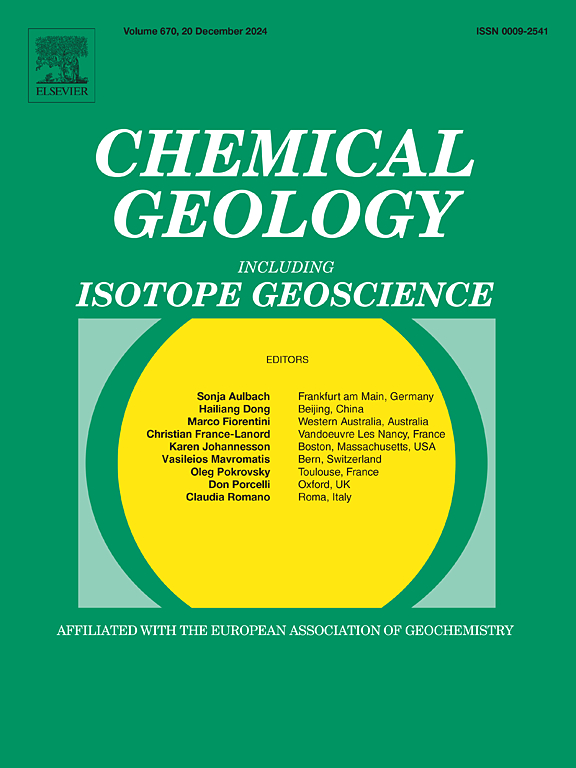墨西哥西部马德雷山和中部梅萨地下水流系统中F、As和U的来源和命运控制
IF 3.6
2区 地球科学
Q1 GEOCHEMISTRY & GEOPHYSICS
引用次数: 0
摘要
氟化物(F)、砷(As)和铀(U)是天然存在的微量元素,人体摄入后会对健康造成不利影响。在墨西哥的奇瓦瓦、萨卡特卡斯和萨利纳斯等城市的地下水中,这些元素的浓度升高,与长英质岩浆序列(流纹岩、火成岩和花岗岩;包括西马德雷山脉和中央梅萨山脉)以及来自这些岩石的沉积物。最近的研究已经确定,这些元素的宿主相是氟磷灰石、黑云母、萤石和玻璃质基质。然而,从岩石和/或沉积物到地下水的不同承载相的再活化机制和效率却很少被描述。结合地下水地球化学分析、不同程度的岩石蚀变和顺序萃取过程(SEP),提出了地下水的运移机制,以及对环境产生较高浓度as、F和U的组分。研究表明,地下水中As、F、U的存在和分布与流纹岩和火成岩的断裂带有关,盆地中部的盆地充填沉积物来源于这类岩石。在许多井中,氟和砷的浓度超过了世界卫生组织(世卫组织)和墨西哥标准规定的饮用水限制数个数量级(60%),这表明存在严重和普遍的水质问题。风化作用是促使F、as和U从含水相向地下水运移的主要机制之一。F、As和U的不同含矿相(F-磷灰石、黑云母和玻璃质基质)、氧化条件(Eh≈340)、中性pH(≈7.7)、高温(>27℃)和区域流动控制并有利于这一过程。结果表明,固相F、As和U主要与F-磷灰石和硅酸盐部分(黑云母和玻璃质基体)相关,而As和U与玻璃质基体相关的硅酸盐部分密切相关。该研究对F、As和U的地球化学和动员过程有了深入的了解,可用于进一步指导该领域保护地下水资源的研究需求。此外,所获得的方法和结果可以转移到拉丁美洲和世界其他地区受地质影响的地区。本文章由计算机程序翻译,如有差异,请以英文原文为准。

Origin and fate control of F, As and U in groundwater flow systems of the Sierra Madre Occidental and Mesa Central, Mexico
Fluoride (F), arsenic (As) and uranium (U) are naturally occurring trace elements that cause adverse health effects when ingested by humans. The groundwater in the cities of Chihuahua, Zacatecas and Salinas, Mexico, have elevated concentrations of these elements that are linked to felsic magmatic sequences (rhyolites, ignimbrites and granites; comprising the Sierra Madre Occidental and Mesa Central) and sediments derived from these rocks. Recent studies have identified that these elements´ host phases are fluorapatite, biotite, fluorite and glassy matrix. However, the remobilization mechanisms and efficiency of the different bearing phases from the rocks and/or sediments to groundwater are rarely characterized. In a multi-method approach that combines the analysis of groundwater geochemistry, different degrees of rock alteration, and sequential extractions procedure (SEP), the mechanisms of mobilization, as well as the fractions that contribute higher concentrations of As, F and U to the environment are proposed. Based on the present study the presence and distribution of As, F and U in groundwater are associated with fault zones in rhyolitic and ignimbrite volcanic rocks, and basin fill sediments derived from this type of rocks, deposited in the central parts of basins. The concentration of F and As exceed the drinking water limits set by both the World Health Organization (WHO) and Mexican standards by several orders of magnitude in numerous wells (>60 %), which indicates a substantial and general water quality problem. Weathering has been identified as one of the main mechanisms favoring F, As and U mobilization from the bearing phases to groundwater. This process is controlled and benefited by the different bearing phases of F, As and U (F-apatite, biotite and glassy matrix), oxidizing conditions (Eh ≈340), neutral pH (≈7.7), high temperatures (>27 °C) and regional flows. The solid phase F, As, and U fractionations were characterized by means of a modified SEP. The results showed that F is mainly linked to F-apatite and the silicate portion (biotite and glassy matrix), while As and U are strongly related to the silicate fraction associated with the glassy matrix. This research gives insight into F, As and U geochemistry and mobilization processes that can be used to further guide research needs in this area for the protection of groundwater resources. In addition, methodologies and results obtained can be transferred to geogenically impacted zones in Latin America and other parts of the world.
求助全文
通过发布文献求助,成功后即可免费获取论文全文。
去求助
来源期刊

Chemical Geology
地学-地球化学与地球物理
CiteScore
7.20
自引率
10.30%
发文量
374
审稿时长
3.6 months
期刊介绍:
Chemical Geology is an international journal that publishes original research papers on isotopic and elemental geochemistry, geochronology and cosmochemistry.
The Journal focuses on chemical processes in igneous, metamorphic, and sedimentary petrology, low- and high-temperature aqueous solutions, biogeochemistry, the environment and cosmochemistry.
Papers that are field, experimentally, or computationally based are appropriate if they are of broad international interest. The Journal generally does not publish papers that are primarily of regional or local interest, or which are primarily focused on remediation and applied geochemistry.
The Journal also welcomes innovative papers dealing with significant analytical advances that are of wide interest in the community and extend significantly beyond the scope of what would be included in the methods section of a standard research paper.
 求助内容:
求助内容: 应助结果提醒方式:
应助结果提醒方式:


